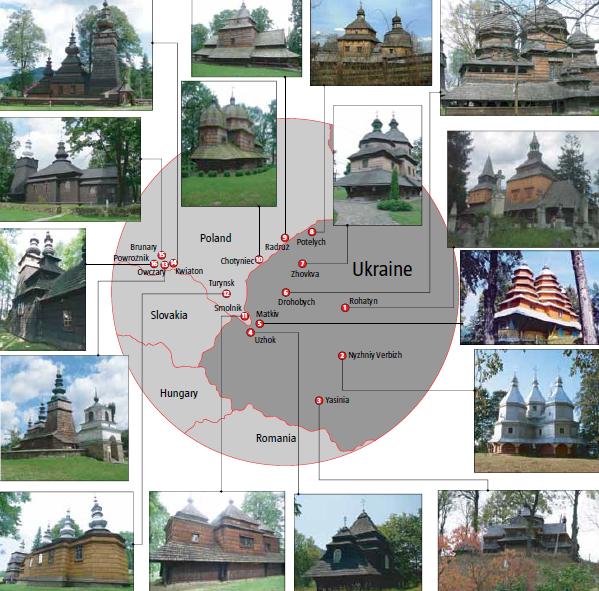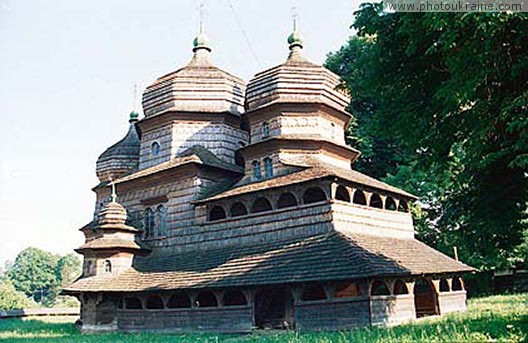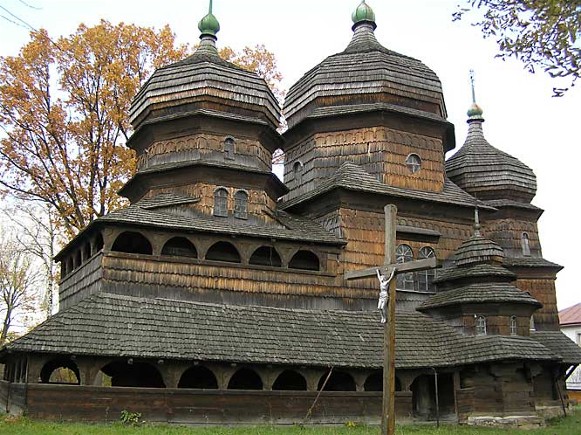 |
| Locations of Wooden Churches in Ukraine and Poland: Source: Ukrainian Weekly |
 |
| St George Church, Drohobych, woodcut by Olena Kulchytska |
 |
| St George, Drohobych, painting by Olena Kulchytska |
 |
| St George Church, Drohobych, Ukraine built c. 1500 |
Three versions of the St George Church, Drobobych, Ukraine.
The picture above, in black and white hung in my grandmother's living room for as long as I can remember. I knew that it was a church in Ukraine, but that's about all the thought I gave it. Later, when my mother had it in her house, and later in her apartment, I became more interested. I asked a person who could speak Ukrainian, who told me the name of the church and of the artist who made the woodcut. Then I decided to do a little research and found the photo (above left) and the painting (above right). The painting is by the same artist as the woodcut, who I discovered was a well known Ukrainian artist. This led me to learn more about the wooden churches in Ukraine. As I looked for information and purchased a book about wooden churches, I discovered that there were also wooden synagogues in Ukraine and Poland, built around the some time. I also found that many are UNESCO World Heritage sites.The map at the top of the page shows the location of some of the churches in Ukraine and Poland. There are no synagogues, because most of them were burned by the Nazis during World War II.
Gwozdziec Synagogue, originally in Hvizdets, Ukraine.
 |
| Gwozdziec Synagogue |
The synagogue was the center of the local Jewish community. It was used for religious services, teaching, and as a place to discuss religious law.
 |
| Bimah; Interior of the rebuilt Gwozdziec Synagogue. |
Synagogue buildings were usually square or rectangular. The main room was large, with a high ceiling. The synagogue was ofter the tallest building in the small towns and villages of Galicia. Most faced east and were located on or near a river. The entrance was on the west side of the building, and led into a vestibule. The women's section was often located above the entrance, but in the synagogue, it was located on the side. The main room was large, with the Bimah, a raised platform covered with a wooden canopy was in the center. Both were decorated with elaborate designs. The Bimah was one of the most important parts of the synagogue, because it was where the Torah and other scriptures were read. The Torah Scrolls were kept on the eastern wall in a Aron-Hakodesh, an elaborate carved altar. Synagogues in Galicia were known for beautiful wall paintings. Other rooms in the building were used for children's education and for mens' Torah study.
Click in the link to read about the reconstruction of the Gwozdziec Synagogue.
A 300 Year-old Synagogue Comes Back to Life in Poland
 |
| Drawing of the Gwozdiec Synagogue by Karol Maszkowski, 1893. |
Wooden Churches
 |
| St George, Drohobych. Source: Encyclopedia of Ukraine. |
The oldest wooden church in Ukraine was built in Hacczow in 1388. The most common building material used in the churches was wood, because it was plentiful and inexpensive. The methods of building were similar to those used in the synagogues, but the style was different. The churches had bell towers which were topped with a cross. St George Church in Drohobych, c.1500, is one of the oldest and best preserved wooden churches in Ukraine. It was build in the Boyko style, with three bell towers and three rooms. (The Boykos lived in the Carpathian mountains and spoke a distinct dialect of the Ukrainian language). Originally the churches had two bell towers, but in time, as new churches were built, more towers were added. There are churches with three, four, five, six or seven individual towers. Builders strive to build churches of great height, but 50 meters was about as high as wooden buildings could be built. To make the building appear taller, each tier was narrower than the one below it, giving the ceiling the appearance of great height. The buildings were elaborately decorated inside, often with beautiful wall paintings and an iconostasis--a wall separating the high altar from the rest of the sanctuary, covered with icons and featuring an elaborate gate in the center.
| Interior of St George Drohobych. Source: Encyclopedia of Ukraine |
Sources:
Encyclopedia of Ukraine.Hewryk, Titus, Masterpieces in Wood: Houses of Worship in Ukraine., The Ukrainian Museum, New York, 1987.
"A 300 Year-old Synagogue Comes Back to Life in Poland" New York Times, June 15, 2011.
For more information:
Carpathian Wooden Churches.blogspot.comUnesco.org: "Wooden Tserkvas of the Carpathian Region of Poland and Ukraine"
Rail, Evan. "In Ukraine, Churches with a Distinctive Allure", New York Times, July 15, 2011.
No comments:
Post a Comment